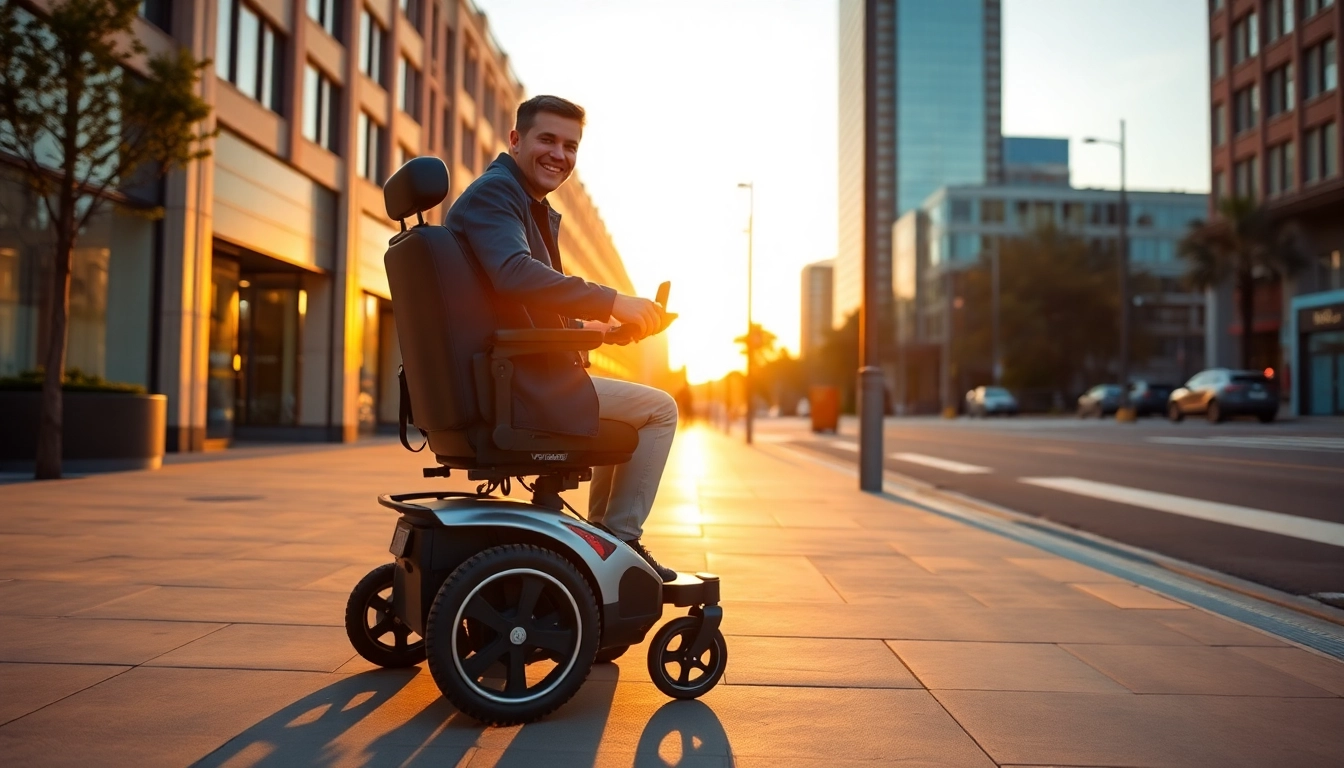Understanding Power Wheelchairs
Power wheelchairs, also known as electric wheelchairs, represent a vital innovation in mobility solutions for individuals with limited physical capabilities. They are designed to provide enhanced freedom and independence, enabling users to navigate various environments with ease. As one considers the benefits of a power wheelchair, it becomes evident that these devices have transformed countless lives by offering both mobility and comfort.
What is a Power Wheelchair?
A power wheelchair is a motorized mobility device that can be controlled using various input methods, such as joystick or control panel, allowing users to move independently. Unlike traditional manual wheelchairs that require physical exertion, power wheelchairs operate on batteries, enabling users to travel longer distances with minimal effort. These devices are equipped with various features tailored to meet the user’s specific needs, making them suitable for a broad range of disabilities and health conditions.
Benefits of Using a Power Wheelchair
- Enhanced Mobility: Users can navigate both indoor and outdoor environments with ease, participating in social activities and daily tasks without relying on others.
- Reduced Physical Strain: Power wheelchairs minimize the physical exertion often required with manual wheelchairs, which is particularly beneficial for individuals with limited upper body strength.
- Independence and Autonomy: Users gain greater control over their mobility, allowing for better participation in personal, social, and professional activities.
- Customization: Many models offer adjustable seating, different speed options, and customizable features to accommodate individual preferences and health conditions.
Key Features to Look For
When selecting a power wheelchair, consider the following features to ensure it meets your needs:
- Battery Life: A longer battery life enables extended travel without needing frequent recharges.
- Weight Capacity: Ensure the wheelchair can support the user’s weight comfortably.
- Control Types: Different models may use joystick controls, touchpads, or specialized switches, catering to varying levels of user mobility.
- Comfort and Support: Features like padded seats, adjustable armrests, and lumbar support are vital for user comfort, especially during long use.
- Portability: For users who travel frequently, lightweight and foldable models may be beneficial.
Types of Power Wheelchairs
The diversity in power wheelchair models means that individuals can choose a design tailored to their specific needs and lifestyle. Below are the most common types:
Portable Power Wheelchairs
Portable power wheelchairs are designed for ease of transportation. They are lightweight, often foldable, and can fit into the trunk of most vehicles. These models are ideal for individuals who travel frequently or need a mobility solution that can be easily stored. Many portable power wheelchairs prioritize battery life without compromising on speed and usability.
Heavy-duty Power Wheelchairs
Heavy-duty power wheelchairs are robust devices designed to support larger weight capacities. They are geared towards users who require additional strength for various terrains or have unique body specifications. These models may include reinforced frames, larger batteries, and enhanced stability features, making them suitable for both indoor and outdoor use on uneven surfaces.
All-terrain Power Wheelchairs
All-terrain power wheelchairs are specifically designed for users who wish to navigate rugged environments. These models feature advanced suspension systems, robust wheels, and enhanced traction capabilities to tackle grass, gravel, and uneven pathways. They allow for a level of autonomy that users might not experience with other wheelchair types, expanding their exploration and activity options.
Choosing the Right Power Wheelchair
Selecting the appropriate power wheelchair is crucial for ensuring comfort, safety, and user satisfaction. Here are crucial considerations when making your choice:
Assessing Your Needs and Lifestyle
Begin by evaluating your specific mobility needs and daily lifestyle. Consider factors such as:
- The severity of your mobility impairment
- Your intended use (e.g., indoor vs. outdoor activities)
- Your typical distance traveled daily
- Any additional features that may benefit you, such as tilt or recline functions
Finding the Right Fit and Comfort
A proper fit is essential for comfort and mobility. When selecting a power wheelchair, pay attention to the following:
- Seat Dimensions: Ensure the seat width, depth, and height match your body measurements.
- Adjustability: Look for adjustable features in seating and armrests for optimal comfort.
- Testing: Utilizing test drives is crucial to determine your comfort level with the wheelchair.
Budget Considerations and Options
The cost of power wheelchairs can vary significantly. Before making a decision, consider the following:
- Quality vs. Price: Investing in a high-quality model may provide better longevity and function.
- Insurance Coverage: Check if your insurance covers the cost of the wheelchair, which may reduce your out-of-pocket expenses.
- Government Assistance Programs: Explore programs that may offer funding or assistance for wheelchair purchases.
Maintaining Your Power Wheelchair
Proper maintenance is essential for ensuring the longevity and functionality of your power wheelchair. Here are some key maintenance tips:
Regular Maintenance Tips
Engaging in routine checks can prevent significant issues down the road:
- Battery Care: Regularly inspect and charge your batteries according to the manufacturer’s guidelines.
- Cleaning: Keep your wheelchair clean and free from debris to ensure optimal performance.
- Inspect Tires: Regularly check tire pressure and tread wear to maintain safety and performance.
Common Repairs and Troubleshooting
Common issues may arise with power wheelchairs that can often be resolved with basic understanding:
- Battery Problems: If the wheelchair fails to operate, check the battery connection and charge level.
- Motor Issues: Listen for unusual noises and report any performance issues to your technician.
- Control System Failures: If controls are unresponsive, check for loose connections or recalibrate if possible.
Upgrades and Accessories for Enhanced Use
To ensure your power wheelchair meets evolving needs, consider the following upgrades and accessories:
- Travel Bags and Storage: These accessories can aid in transporting necessary items while on the go.
- Comfort Cushions: Specialized cushions can provide additional support and pressure relief.
- Visibility Accessories: Lights and reflectors can enhance safety during evening or low-light use.
Real-life Experiences with Power Wheelchairs
Stories of real users can provide invaluable insights into the impact of power wheelchairs. Here are a few testimonials that illustrate their transformative role in mobility and independence:
Customer Testimonials and Stories
Many users report significant changes in their quality of life after obtaining a power wheelchair. For example:
“Before getting my power wheelchair, my world felt small. Now, I can go out with friends, attend family gatherings, and even explore parks. It has changed everything for me.” – Sarah, 34
“I was hesitant at first, thinking I wouldn’t need one, but after trying out different models, I found the perfect fit. It’s made my daily commute to work so much easier and has given me independence I never thought possible.” – John, 45
How Power Wheelchairs Have Transformed Lives
The transformative power of mobility devices extends beyond simple movement. Many users describe reinvigorating activities they once enjoyed:
- Engaging in Hobbies: With mobility support, users can rediscover hobbies like gardening, shopping, or even attending sporting events.
- Connecting with Community: Power wheelchairs provide the means to engage with friends, family, and community groups, enhancing social interaction.
- Pursuing Employment: For many, improved mobility has opened doors to job opportunities, enabling self-sufficiency and contributing to their communities.
Community Support and Resources
Finding support within the community is crucial for power wheelchair users. Various resources exist, including:
- Local Support Groups: Many communities have support networks that provide advice and friendship for new users.
- Online Forums: Numerous websites and forums offer insights from fellow wheelchair users and tips on using different models effectively.
- Healthcare Resources: Consulting with healthcare professionals can provide additional personalized solutions to mobility challenges.



